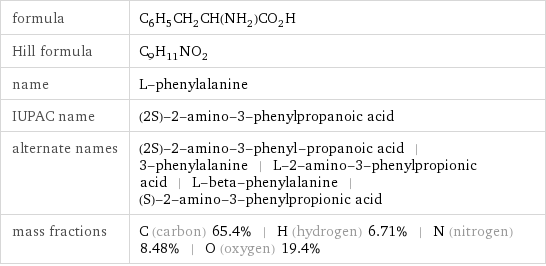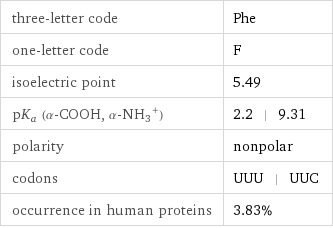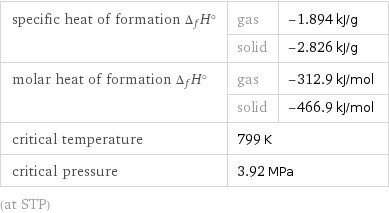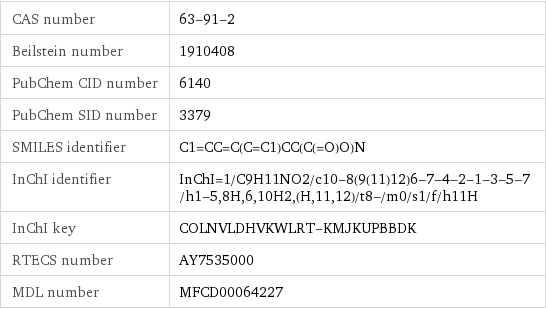Input interpretation

L-phenylalanine
Chemical names and formulas

formula | C_6H_5CH_2CH(NH_2)CO_2H Hill formula | C_9H_11NO_2 name | L-phenylalanine IUPAC name | (2S)-2-amino-3-phenylpropanoic acid alternate names | (2S)-2-amino-3-phenyl-propanoic acid | 3-phenylalanine | L-2-amino-3-phenylpropionic acid | L-beta-phenylalanine | (S)-2-amino-3-phenylpropionic acid mass fractions | C (carbon) 65.4% | H (hydrogen) 6.71% | N (nitrogen) 8.48% | O (oxygen) 19.4%
Lewis structure

Draw the Lewis structure of L-phenylalanine. Start by drawing the overall structure of the molecule, ignoring potential double and triple bonds: Count the total valence electrons of the carbon (n_C, val = 4), hydrogen (n_H, val = 1), nitrogen (n_N, val = 5), and oxygen (n_O, val = 6) atoms: 9 n_C, val + 11 n_H, val + n_N, val + 2 n_O, val = 64 Calculate the number of electrons needed to completely fill the valence shells for carbon (n_C, full = 8), hydrogen (n_H, full = 2), nitrogen (n_N, full = 8), and oxygen (n_O, full = 8): 9 n_C, full + 11 n_H, full + n_N, full + 2 n_O, full = 118 Subtracting these two numbers shows that 118 - 64 = 54 bonding electrons are needed. Each bond has two electrons, so in addition to the 23 bonds already present in the diagram add 4 bonds. To minimize formal charge oxygen wants 2 bonds and carbon wants 4 bonds. Identify the atoms that want additional bonds and the number of electrons remaining on each atom: Fill in the 4 bonds by pairing electrons between adjacent highlighted atoms. Note that the six atom ring is aromatic, so that the single and double bonds may be rearranged: Answer: | |
3D structure

3D structure
Basic properties

molar mass | 165.19 g/mol phase | solid (at STP) melting point | 272.5 °C boiling point | 313 °C density | 0.754 g/cm^3
Units

Hydrophobicity and permeability properties

experimental LogP hydrophobicity | -1.4 predicted LogP hydrophobicity | -1.35 predicted LogS | -1.6
Basic drug properties

approval status | approved | nutraceutical | small molecule drug categories | dietary supplement | essential amino acid | micronutrient
Amino acid properties

three-letter code | Phe one-letter code | F isoelectric point | 5.49 pK_a (α-COOH, (α-NH_3)^+) | 2.2 | 9.31 polarity | nonpolar codons | UUU | UUC occurrence in human proteins | 3.83%
Solid properties (at STP)

density | 0.754 g/cm^3 vapor pressure | 4×10^-4 mmHg (at 25 °C)
Units

Thermodynamic properties

specific heat of formation Δ_fH° | gas | -1.894 kJ/g | solid | -2.826 kJ/g molar heat of formation Δ_fH° | gas | -312.9 kJ/mol | solid | -466.9 kJ/mol critical temperature | 799 K | critical pressure | 3.92 MPa | (at STP)
Chemical identifiers

CAS number | 63-91-2 Beilstein number | 1910408 PubChem CID number | 6140 PubChem SID number | 3379 SMILES identifier | C1=CC=C(C=C1)CC(C(=O)O)N InChI identifier | InChI=1/C9H11NO2/c10-8(9(11)12)6-7-4-2-1-3-5-7/h1-5, 8H, 6, 10H2, (H, 11, 12)/t8-/m0/s1/f/h11H InChI key | COLNVLDHVKWLRT-KMJKUPBBDK RTECS number | AY7535000 MDL number | MFCD00064227
NFPA label

NFPA label

NFPA health rating | 1 NFPA fire rating | 0 NFPA reactivity rating | 0
Toxicity properties

RTECS classes | mutagen | reproductive effector